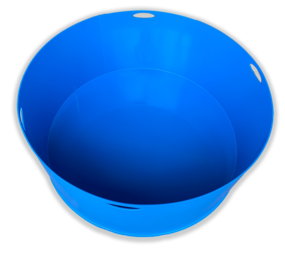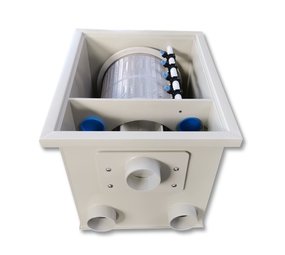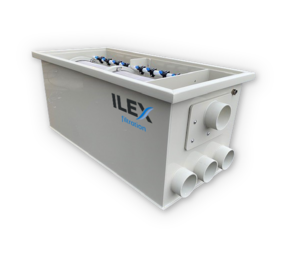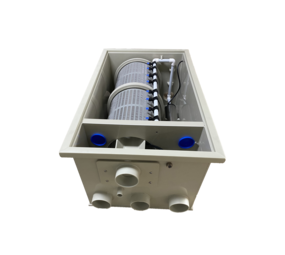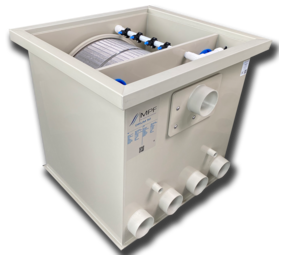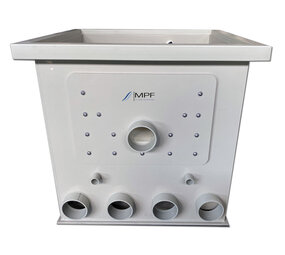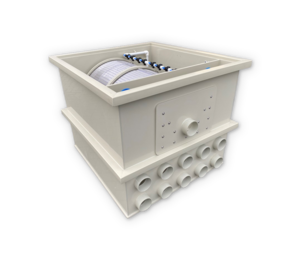Drumfilters
How does an MPF drum filter work?
A drum filter is a pre-filter that can easily filter very fine pollution (<70mu) from a water flow. The water flows gravity or pump fed into the drum filter thereby separating the dirt from the water. The water flows from the inside of the drum filter through the wall to the outside of the drum filter. A mesh has been mounted on the wall of the drum, which has a certain fineness. The pollution remains on this mesh. With a certain amount of pollution, the drum filter will clog up completely.
For this purpose, there is an automatic control with the drum filter that monitors this. This control constantly measures the water level in the drum filter. This is possible with gravity systems behind and with pump fed systems in front of the drum filter. The moment the drum filter clogs up, the water level will change. In the gravity system the water level drops behind the drum. In a pump fed system the water level in front of the drum rises.
What is the best setup for my drum filter?
We always recommend setting up the filter in gravity. The filter is placed at water level and will then protrude approximately 11-14 cm above the water level. Due to the effect of gravity, your filter fills up with water. A pond pump moves the water from your filter back to the pond.
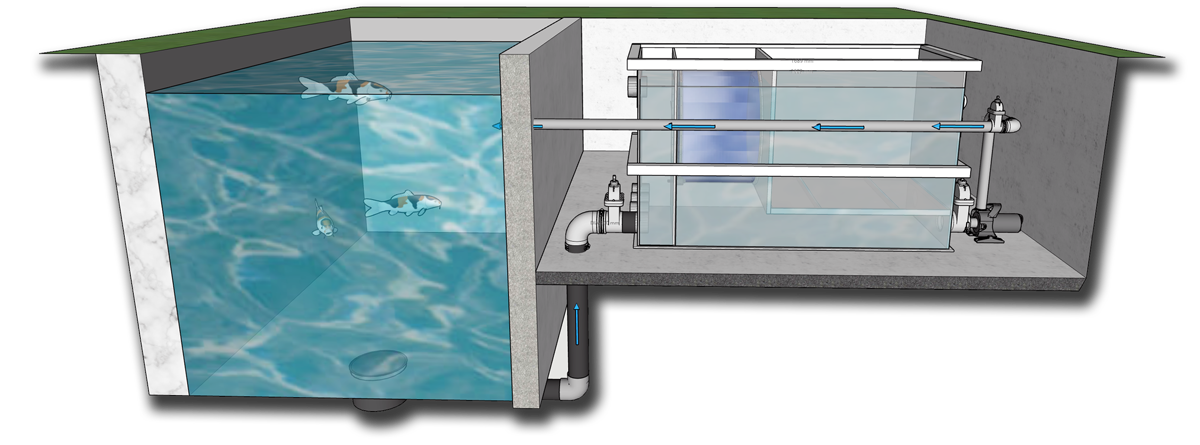
What is the capacity of a pump fed drum filter system?
If a pump-fed system is chosen, there are a number of things to consider. First, pump fed systems have less capacity. Take a loss of 30% into account. For example, a Biodrum 100 can handle a maximum of 50m3 per hour in gravity setup, and a pump-fed system a maximum of 35m3. The biochamber will also not be completely filled with water, so less biological material will be able to enter. Our advice is to always go for a gravity system.
If a difference is measured, the electronics will activate the flushing. During this flushing, the drive motor turns the drum filter and a high pressure pump from the nozzles (the mouthpiece) sprays the screen. The nozzles spray the water in from the outside of the drum to remove the dirt. This dirty water is collected on the inside of the drum filter by means of a gutter through which the water flows to the sewer. Once the water level is back at the correct level, the drum filter will flush for 20 seconds to ensure proper cleaning. After this, the pressure pump and drive motor will switch off and the electronics will continue its measurement until the next flush.
Our controls
Through years of testing and innovation, we have developed 2 types of controllers for our filters. The simple MPF controller electronics and the MPF Professsional Drum control with Siemens logo control.
MPF CONTROLLER
Standard supplied with each filter.
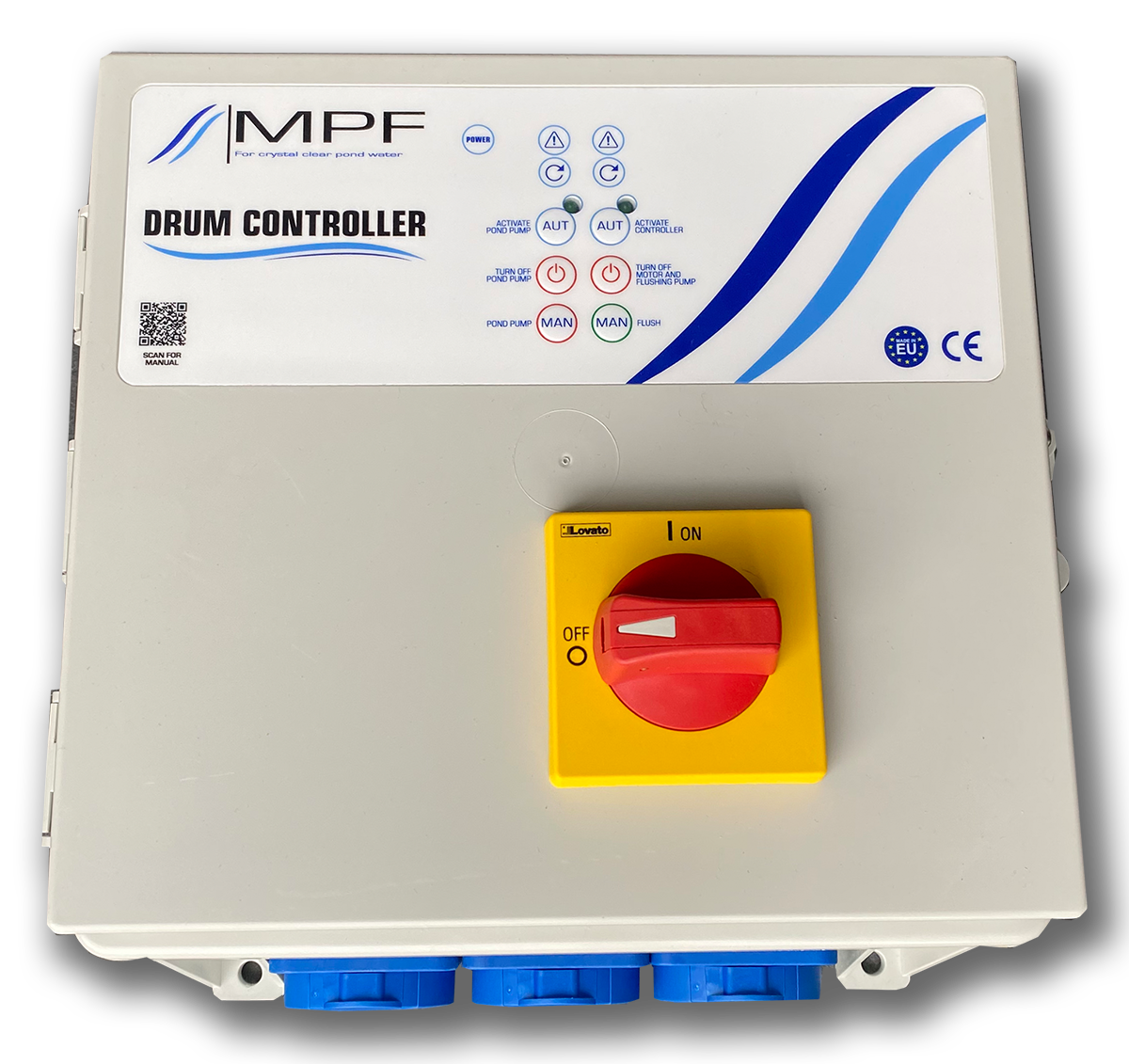
- The pond pump stops when the water level is too low and turns on again when the water level in the pond is raised again.
- Industrial electronics cabinet in a compact housing
- Provides automatic flushing
- Industrial Relay 16A
- Manual flushing by push button
- Digital display
Option:
MPF Professional Control with siemens logo controller.
This electronics with Siemens Logo 8 controller is a new generation logic module suitable for any customer requirement and is extremely reliable. So reliable that even the large water treatment plants work with Siemens! (surcharge €350,00)

The pond pump stops when the water level is too low and turns on again when the water level in the pond is raised again
- Provides automatic flushing
- You can read the data via internet
- Via an app you can control the Siemens Logo8
- Change flushes yourself if you want longer or shorter flushes
- A daily counter is integrated so you can read out the total number of flushes and daily flushes
- A signal is given when the drum has been in the dry run protection mode
- Possibility to flush your gutter by connecting an additional flushing pump
- Many possibilities to expand the drum to your liking
- 1 x per hour rinsing to prevent the fabric from drying out (winter mode)
Drum UV connections
Each MPF filter is equipped with one or two Drum UV inputs. This makes it easy to install an MPF Drum UV using a rubber coupling.
The MPF drum filters (Drum 30/50/100) come with an external flushing pump from Oase with a 3-year warranty. There is the option to have an internal flushing pump built into the Drum 50 and 100
The Ilex drum 20 has a capacity to...
The Ilex drum 20 has a ...
Ilex drum 40 drum filter PP. Compa...
Ilex drum 40 drum filte...
- OUR DEALERS
- Do you also want to become a dealer? Then click here.
- Own service team
A drum filter 30 with an internal ...
A drum filter 30 with a...
Ilex drum 40 drum filter PP. Compa...
Ilex drum 40 drum filte...
MPF Drum 50 trommelfilter ✅ Capa...
MPF Drum 50 trommelfilt...
MPF Drum 50 Pro ✅ Capacity to pu...
MPF Drum 50 Pro ✅ Cap...
MPF Rotating Drum Filter 100 Pro H...
MPF Rotating Drum Filte...
The MPF Drum 200, perfect for koi ...
The MPF Drum 200, perfe...
Overige categorieën in Drumfilters
Drumfilters
How does an MPF drum filter work?
A drum filter is a pre-filter that can easily filter very fine pollution (<70mu) from a water flow. The water flows gravity or pump fed into the drum filter thereby separating the dirt from the water. The water flows from the inside of the drum filter through the wall to the outside of the drum filter. A mesh has been mounted on the wall of the drum, which has a certain fineness. The pollution remains on this mesh. With a certain amount of pollution, the drum filter will clog up completely.
For this purpose, there is an automatic control with the drum filter that monitors this. This control constantly measures the water level in the drum filter. This is possible with gravity systems behind and with pump fed systems in front of the drum filter. The moment the drum filter clogs up, the water level will change. In the gravity system the water level drops behind the drum. In a pump fed system the water level in front of the drum rises.
What is the best setup for my drum filter?
We always recommend setting up the filter in gravity. The filter is placed at water level and will then protrude approximately 11-14 cm above the water level. Due to the effect of gravity, your filter fills up with water. A pond pump moves the water from your filter back to the pond.

What is the capacity of a pump fed drum filter system?
If a pump-fed system is chosen, there are a number of things to consider. First, pump fed systems have less capacity. Take a loss of 30% into account. For example, a Biodrum 100 can handle a maximum of 50m3 per hour in gravity setup, and a pump-fed system a maximum of 35m3. The biochamber will also not be completely filled with water, so less biological material will be able to enter. Our advice is to always go for a gravity system.
If a difference is measured, the electronics will activate the flushing. During this flushing, the drive motor turns the drum filter and a high pressure pump from the nozzles (the mouthpiece) sprays the screen. The nozzles spray the water in from the outside of the drum to remove the dirt. This dirty water is collected on the inside of the drum filter by means of a gutter through which the water flows to the sewer. Once the water level is back at the correct level, the drum filter will flush for 20 seconds to ensure proper cleaning. After this, the pressure pump and drive motor will switch off and the electronics will continue its measurement until the next flush.
Our controls
Through years of testing and innovation, we have developed 2 types of controllers for our filters. The simple MPF controller electronics and the MPF Professsional Drum control with Siemens logo control.
MPF CONTROLLER
Standard supplied with each filter.

- The pond pump stops when the water level is too low and turns on again when the water level in the pond is raised again.
- Industrial electronics cabinet in a compact housing
- Provides automatic flushing
- Industrial Relay 16A
- Manual flushing by push button
- Digital display
Option:
MPF Professional Control with siemens logo controller.
This electronics with Siemens Logo 8 controller is a new generation logic module suitable for any customer requirement and is extremely reliable. So reliable that even the large water treatment plants work with Siemens! (surcharge €350,00)

The pond pump stops when the water level is too low and turns on again when the water level in the pond is raised again
- Provides automatic flushing
- You can read the data via internet
- Via an app you can control the Siemens Logo8
- Change flushes yourself if you want longer or shorter flushes
- A daily counter is integrated so you can read out the total number of flushes and daily flushes
- A signal is given when the drum has been in the dry run protection mode
- Possibility to flush your gutter by connecting an additional flushing pump
- Many possibilities to expand the drum to your liking
- 1 x per hour rinsing to prevent the fabric from drying out (winter mode)
Drum UV connections
Each MPF filter is equipped with one or two Drum UV inputs. This makes it easy to install an MPF Drum UV using a rubber coupling.
The MPF drum filters (Drum 30/50/100) come with an external flushing pump from Oase with a 3-year warranty. There is the option to have an internal flushing pump built into the Drum 50 and 100


 MAINTENANCE AND WARRANTY
MAINTENANCE AND WARRANTY Why a drum filter?
Why a drum filter? Drumfilters
Drumfilters Biodrum combi drumfilters
Biodrum combi drumfilters Biodrum rotator drumfilters
Biodrum rotator drumfilters Biodrum Gravity Trickle
Biodrum Gravity Trickle OPTIONS
OPTIONS Plug and Play Filterunits
Plug and Play Filterunits Nanobubble Generator
Nanobubble Generator  Swimming pond filter
Swimming pond filter Multi-chamber filters
Multi-chamber filters Trickle filter
Trickle filter Moving bed / Pump room
Moving bed / Pump room TAILORED PLASTIC SOLUTIONS
TAILORED PLASTIC SOLUTIONS Bacteria/ Start-up
Bacteria/ Start-up Air pumps
Air pumps Connection materials
Connection materials Drum-UV lights
Drum-UV lights Drum filters parts
Drum filters parts Other products
Other products User manual
User manual  Our dealers
Our dealers DOWNLOADS
DOWNLOADS 